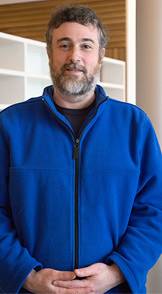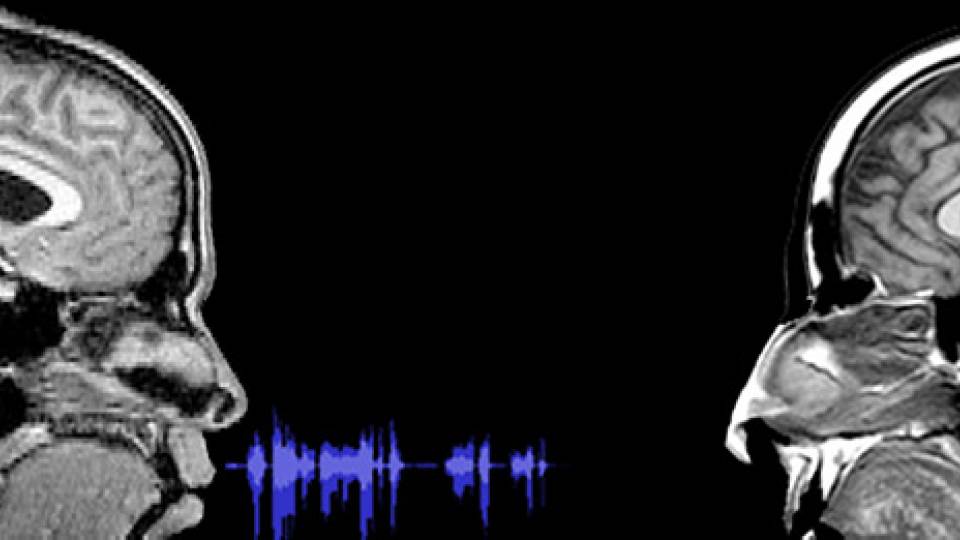No matter how different they seem — the learned and contemplative neuroscientist versus the toy orangutan with a penchant for off-color jokes — almost any adult who experiences them knows that Princeton University professor Michael Graziano is the voice behind his simian puppet Kevin. Yet to most listeners, Kevin — who acts as the comic relief when Graziano publicly presents his work — nonetheless has a distinct personality and consciousness — he seems aware of and comments on his surroundings in his own unique way.
While Kevin is not "real" in the sense of being an animate biological being, Graziano, a professor of psychology and the Princeton Neuroscience Institute, suggests that humans attribute consciousness to the puppet in the same way that we attribute consciousness to each other and to ourselves. Graziano has developed a new theory of consciousness he calls the "attention schema theory" that suggests that specialized systems in the human brain compute information about the things of which a person is aware, and project the property of consciousness onto ourselves and others. In that sense, the puppet's consciousness is every bit as real as that of anyone wincingly laughing at his jokes about living atop Graziano's hand.

Graziano identifies two brain areas that most likely create the model of attention that leads to awareness (above). The superior temporal sulcus is linked to the ability to follow people's gaze and determine where another's attention is directed. The temporoparietal junction has been linked to processing internal and external information, and the ability to distinguish between oneself and others. These regions have been shown to be active when people try to understand the minds of other people, as well as when people redirect their attention. Just as important, damage to these regions has been shown to result in a poor ability to interpret other people's actions and emotions, as well as a condition known as neglect wherein a person becomes totally unaware of anything on the side of the body opposite to the brain damage. This image is of Graziano's brain. (Image courtesy of Michael Graziano, Department of Psychology)
Most people consider consciousness to be the complete, non-physical mental package that makes up a person — personality, memories, experiences and emotions. They also consider awareness to be more focused — you are aware of specific items in your consciousness. Most people tend not to be bothered by the notion that some "magic" seems to happen so that when a person looks at a red apple, their brain doesn't merely register the information, it experiences the color.
Scientists who study consciousness believe if we can explain how a brain becomes aware of something, we can explain the larger phenomenon of consciousness. In most scientific theories, awareness emerges from the physical functioning of the brain, almost like heat rising from circuits. Most researchers therefore look for the physical mechanisms in the brain that might generate the non-physical awareness.
Laid out in his recent book, "Consciousness and the Social Brain" (Oxford University Press, 2013), Graziano's theory takes a completely different approach to explaining consciousness. "In this theory, the brain is an information-processing device. It doesn't produce non-physical essences — it computes information," Graziano said.
"We know that it accesses internal data and concludes that it has a 'magical' inner feeling. What scientific questions are we going to ask about that process," Graziano said. "Most researchers wonder how the magic is produced, but I think that's a red herring. Instead, I want to know the advantage of the brain computing an informational model of itself that contains an attribution of magic. Does it help to control behavior? How did it evolve? I want to know the systems in the brain that compute it, and what happens when those systems are damaged."
The theory is based on two very basic actions that all brains perform. The first is paying attention, which for a neuroscientist is a data-handling trick. So many signals come into the brain from outside and inside the body that only a minority of them can be processed at any one time. Attention is a complex process that allows us to focus on a few signals, process them deeply and then react to them. Second, all brains organize these processed signals in order to construct informational models of things in the world. Brains understand the world through models of objects, people and even the self.
In Graziano's attention schema theory, awareness is the brain's simplified model of the complicated process of attention. When a person is aware of something such as an apple in front of them, it is because the brain has put together two models: the information describing the apple, and the self-descriptive information about how the brain is focusing its resources. Put those two specialized types of information together and the brain is equipped to introspect, conclude and report, "I am aware of the apple."
The attention schema theory satisfies two problems of understanding consciousness, said Aaron Schurger, a senior researcher of cognitive neuroscience at the Brain Mind Institute at the École Polytechnique Fédérale de Lausanne in Switzerland who received his doctorate from Princeton in 2009. The "easy" problem relates to correlating brain activity with the presence and absence of consciousness, he said. The "hard" problem has been to determine how consciousness comes about in the first place. Essentially all existing theories of consciousness have addressed only the easy problem. Graziano shows that the solution to the hard problem might be that the brain describes some of the information that it is actively processing as conscious because that is a useful description of its own process of attention, Schurger said.
"Michael's theory explains the connection between attention and consciousness in a very elegant and compelling way," Schurger said.
"His theory is the first theory that I know of to take both the easy and the hard problems head on," he said. "That is a gaping hole in all other modern theories, and it is deftly plugged by Michael's theory. Even if you think his theory is wrong, his theory reminds us that any theory that avoids the hard problem has almost certainly missed the mark, because a plausible solution — his theory — exists that does not appeal to magic or mysterious, as-yet-unexplained phenomena."

To most people, awareness is more specific than consciousness. We are aware of specific information. The diagram above shows that all the information of which we are aware, plus the process of becoming aware of it, make up consciousness. (Image courtesy of Michael Graziano, Department of Psychology)
The brain versus the magic
Graziano has identified two brain areas that most likely create this model of attention. The first is the superior temporal sulcus, which is in the lower portion of the brain and part of the temporal lobe. This area is linked to the ability to follow people's gaze and determine where another's attention is directed. Working with the superior temporal sulcus is the temporoparietal junction, which is toward the upper rear of the brain where the parietal and temporal lobes meet. This area has been linked to processing internal and external information, and the ability to distinguish between oneself and others.
Together, these regions have been shown to be active when people try to understand the minds of other people, as well as when people redirect their attention. Just as important as how these regions function is the effect on a person when these areas malfunction, Graziano writes. Damage to these regions has been shown to result in a poor ability to interpret other people's actions and emotions, as well as a condition known as neglect wherein a person becomes totally unaware of any person or object on the side of the body opposite to the brain damage. An example would be a person who can describe the right side of a street but for whom the left side might as well not exist.
Graziano and his group plan to explore these regions with functional magnetic resonance imaging (fMRI), such as by capturing images of a person's brain as they attribute awareness to themselves versus others, in order to zero in on the different activity that takes place. Despite the work to be done, Graziano sees his theory as having the advantage of at least identifying a possible root of consciousness and a physical process by which it occurs.
In general, theories of consciousness, from the ancient Greeks to modern neuroscience, come to a point where consciousness just happens, be it due to a magic fluid as proposed by 17th-century French philosopher René Descartes, or the harmonious firing of a billion little brain cells proposed by modern neuroscience. In these theories, the brain suddenly becomes aware and understands its relationship to everything around it, somewhat like an evil computer in a science-fiction movie. Graziano likens these explanations to crediting the magician instead of explaining the trick.
"The question has always been how does a brain produce the inner 'magic.' What we're asking is, 'How does the brain attribute magic to itself,' and that's a fundamentally different way to frame the question," he said.
"Every past theory of consciousness has a gap. Even the most modern theories at some point just point to a circuit and say, 'And then awareness appears.' But understanding where the magic comes from is pointless," Graziano continued. "The phenomenon that scientists can say with certainty happens is that the brain attributes the 'magic' to itself. We can understand how that happens and the computations behind it. And that's what this theory attempts to do."
Graziano has given consciousness a more solid footing in the real, tangible world even if it remains a creation of the brain, Schurger said. The attention schema theory provides a physical mechanism to explain consciousness.
"If anything, his theory stands to demystify consciousness, in the same way that our understanding of genetics and self-organizing systems has begun to demystify 'life,' which was once thought to depend on an unseen force," Schurger said.
"The only thing for science to explain about consciousness is not, 'Why is there something more inside of us, apart from just input, processing and output,' but rather, 'Why do we insist that there is something more inside of us,'" he said. "The answer given by Michael's theory is that this is the way the brain describes the process of attention happening inside the brain itself. Even if the phenomenon being described is real, the description does not have to be real."

Graziano and researchers in his group such as graduate student Taylor Webb (right) plan to explore the brain regions Graziano suggests are linked with awareness using functional magnetic resonance imaging (fMRI). Their studies will include capturing images of a person's brain as they attribute awareness to themselves versus others in order to zero in on the different activity that takes place.
Origin of an idea
After 20 years of influential research on sensory processing, movement control and other connections in the brain-body cooperative, Graziano needed to focus on something new. Graziano received his bachelor's degree in 1989 and his doctorate in 1996 from Princeton, afterward working as a researcher at the University before joining the faculty in 2001. "I got to the point where I felt I wasn't contributing fundamental new research anymore," he said of his transition. "I was merely defending my turf."
Consciousness is one of three main areas Graziano has studied. The first relates to how the brain monitors the space around the body through vision, hearing and touch. In the 1990s and early 2000s, Graziano published a series of papers in the journals Science and Nature suggesting that the brain keeps track of a bubble of space around the body in order to guide movement, and revealed a set of connected brain regions that seemed to be responsible for that ability. Discover Magazine named the research one of the top discoveries of 1997.
Graziano also explored how the brain controls movement via the brain region known as the motor cortex, which scientists had thought contained a simple "map" of the body's individual muscles. The map turned out to be much more complex than expected. In the early 2000s, Graziano showed that if specific spots in the motor cortex were stimulated then very complex movements would result. For example, when one site in the motor cortex is stimulated, the hand closes into grip-like position and moves toward the mouth as the mouth opens, all in a coordinated fashion. These findings upended the existing notion of a simple map of individual muscles in the motor cortex.
The latest book on consciousness stems from an early outline of his theory that Graziano published in 2011 in the journal Cognitive Neuroscience with Sabine Kastner, a Princeton professor of psychology and the Princeton Neuroscience Institute. That paper was a result of his 2010 book, "God Soul Mind Brain" (Leapfrog Press, 2010), which was a discussion about existing work on consciousness written for a non-scientific audience. It was then that Graziano inadvertently introduced himself to his new and third major field of study.
"That book is about how we attribute awareness to others and how we might also attribute awareness to ourselves. It proposes that human spirituality is a result of attributing awareness to objects and empty spaces," Graziano said.
"I didn't realize when I wrote the book that the theory would be considered a new theory of human consciousness. It seemed like common sense to me, but surprised a lot of people," he said. "That is how I began to explore in more detail how a brain might attribute this property of awareness to itself and what the usefulness of that attribution might be."
Graziano's study of consciousness is in keeping with his creative approach to research and also helps round out the department's expertise, said Deborah Prentice, the Alexander Stewart 1886 Professor of Psychology and Public Affairs and psychology department chair. Consciousness is a persistent topic in psychology that was even pondered by the 19th-century philosopher and psychologist William James, known as the "father of American psychology," Prentice said. Yet, she said, no one at Princeton has delved into it since Anne Treisman, the James S. McDonnell Distinguished University Professor of Psychology, Emeritus, who retired in 2010.
"Michael is a fantastic scientist and a very creative researcher. He is best known for his work on the motor cortex, which fundamentally and persuasively challenged the prevailing orthodoxy about how that region of the brain is organized," Prentice said.
"The study of consciousness is a bold, new direction for him," she said. "Michael's work is always interesting and always thought-provoking. I am eager to see where it goes."
As time goes on, Graziano is able to better explain his theory and his colleagues can better understand it. But he allows that of the doubt he's received, the majority of it cannot be assuaged — people believe in a special human magic and want to know where it comes from.
"People say, 'Great, you've explained how brains claim to have magic inside them, but you haven't explained the actual magic.' That's almost impossible to get people to see from the opposite perspective," he said. "Ninety percent of the pushback comes from that belief in magic. It's really almost like an ideological difference."
Colleagues such as Schurger who are supportive of his idea have commended Graziano on providing an explanation of consciousness that considers and correlates with the available evidence on how the brain physically works, he said.
"To me that's really important. This theory explains an area that has been so murky that nobody could see through to an explanation," Graziano said.
"There are two questions to ask about this theory: First, does it provide an actual explanation, or does it just appeal to magic like so many other theories? And second, is it correct? The answer to the first question is yes," he said. "As for the second, that's up in the air. I'm very encouraged by it, but one never knows, I suppose."




